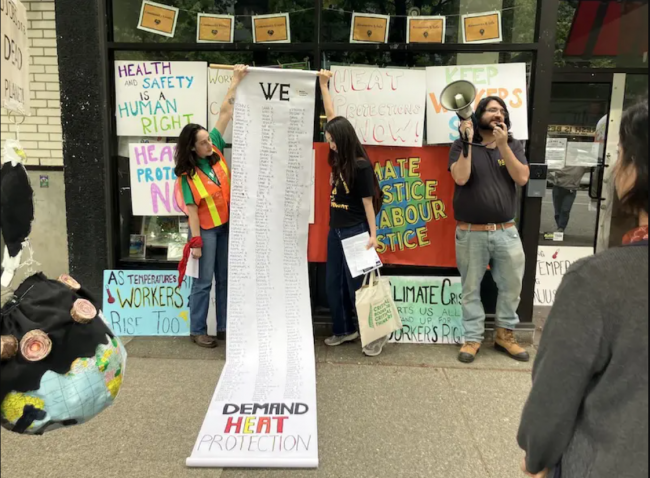Articles Menu

May 26, 2025
In 2021, the heat dome over British Columbia killed 619 people, marking the deadliest climate disaster in Canadian history. As the province baked—temperatures surpassed 35°C—many workers in restaurants, farms, and other high-exposure jobs still had to clock in. Four years later, workers are still pushing for legal protections from extreme heat.
On May 23, the Worker Solidarity Network (WSN) rallied outside Premier David Eby’s Kitsilano office in Vancouver. WSN is a coalition of non-unionized and precarious workers—including farmhands and restaurant staff in low-wage, unstable, or temporary jobs with few protections—advocating for climate protections in the workplace. Their demands include a maximum working temperature, paid climate leave, and audits that ensure employers are adhering to existing safety regulations.
Over the past year, more than 1,000 people sent letters demanding audits and greater heat protection for vulnerable groups to Eby and B.C.’s health and labour ministries, through WSN’s “too hot to work!” campaign. On Friday, the coalition unveiled a banner with the names of the 1,000 signatories.
WorkSafeBC, the provincial agency that regulates occupational health and safety, says workers have the right to refuse work in unsafe conditions. But WSN writes in a report that many workers can’t afford to forego wages by refusing work, nor can they speak up against employers’ demands.
Yet, 80% of food service workers in a WSN focus group said extreme weather affected their job, including changes like reduced hours, overtime work, or being asked to take on duties beyond their role. For many precarious workers, missing a paycheque to prioritize safety isn’t an option.
“Staying home doesn’t pay the rent,” a worker told WSN organizer Ismail Askin after returning to his kitchen job despite suffering a heatstroke in the summer of 2021. Witnessing that, Askin said, pushed him to advocate for climate protections in the workplace.
Four years later, little has changed.
After the heat dome, Worksafe BC reminded employers that they are required to conduct heat stress assessments and develop exposure control plans in consultation with workers. It has also updated its resources for employers and workers, and recommended that employers increase staffing to reduce exposure.
“WorkSafeBC conducts proactive inspections as well as inspections in response to requests from external parties, such as workers and the public,” a Ministry of Labour spokesperson wrote in a statement May 26.
But it has not made legislative changes nor increased audits to enforce worker protections.
Workplace claims related to heat stress for indoor workers rose 180% in 2021. Still, many job sites remain without air conditioning or other cooling infrastructure. According to WorkSafeBC, 52% of serious heat stress claims in 2021 came from indoor workplaces without sufficient ventilation.
A new report finds that workplace injuries may also be severely underreported to the agency, due to a system that financially rewards employers with fewer reported claims.
Amid rising risks to workers, WSN Communications Coordinator Jiyoon Ha points to countries like Spain, where workers gained four days of paid climate leave after deadly floods in 2021. Nothing similar exists in Canada.
Migrant workers face even greater precarity than others, Ingrid Mendez, executive director of the Migrant Justice Centre, said in a speech at the rally. Mendez said Canada’s temporary foreign worker programs leave migrant workers with few protections from employer exploitation and unsafe environmental conditions.
“They are threatened that if they complain they will be sent back to their country,” Mendez said. The programs use closed work permits, which tie workers to a single employer. If employers place workers in unsafe conditions, they do not have the option to quit and find work elsewhere.
Since the report’s publication in 2023, Ha said little has changed in the legal system for B.C. workers.
“The government has turned a blind eye,” she said.
In the meantime, the WSN has expanded workers’ rights trainings across the interior parts of the province to help workers advocate for themselves.
“Workers deserve climate crisis protections, workers deserve heat protections, and workers deserve rights,” Askin said.
[Top photo: Tova Gaster/The Energy Mix]